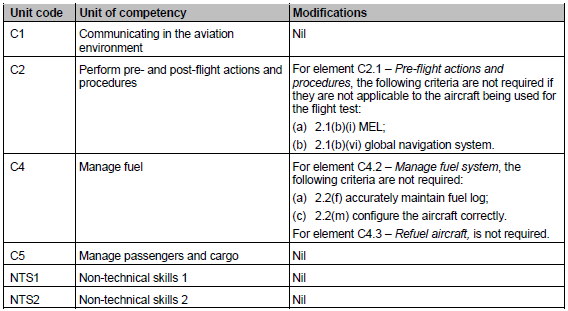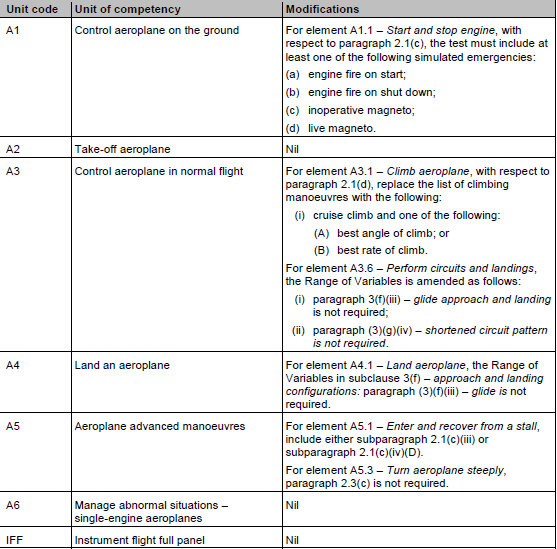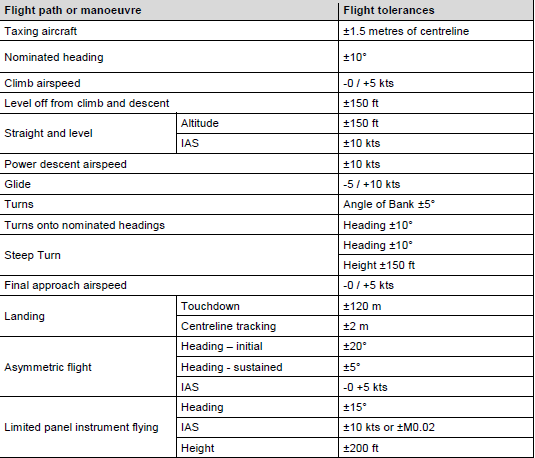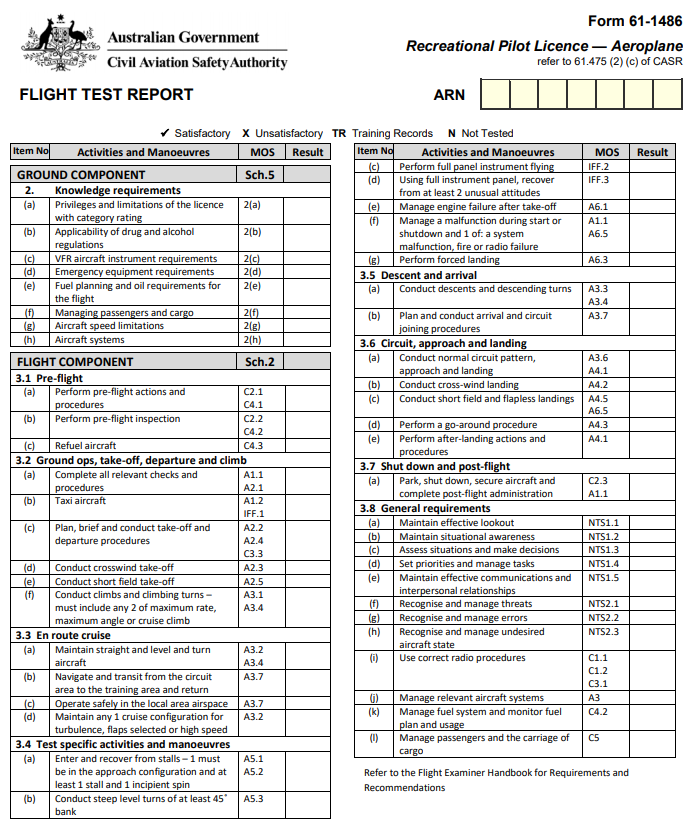RPL Flight Test
Flight School Knowledge
For use when flight schools issue an in house Aeronautical Knowledge written or oral test. Do 20 random from 70+ questions.
Start Practice ExamFlight Test Questions
For use to prepare for some of the possible flight test questions. Do 20 random from 60+ questions. Use in conjunction with the Flight School Knowledge practice exam.
Start Practice ExamFrom https://www.legislation.gov.au/Details/F2016C00540/Download
Disclaimer – This May Change Without Notice – Please Check Using The Link Above
RPLH test forms HERE
RPLA & RPLH Examiner Handbook Section
PART 61 MANUAL OF STANDARDS – VOLUME 4 -SCHEDULE 5 – PAGE 573
SECTION G RECREATIONAL PILOT LICENCE (RPL)
Appendix G.1 RPL Aeroplane category rating flight test
1. Flight test requirements1.1 An applicant for a recreational pilot licence with aeroplane category rating flight test must demonstrate her or his competency, in the units of competency mentioned in clause 3, by performing manoeuvres in an aeroplane, within the flight tolerances specified in table 1 in Section 1 of Schedule 8 of this MOS.
1.2 For subclause 1.1, a sustained deviation outside the applicable flight tolerance is not permitted.
1.3 For Schedule 2 elements A2.3 and A4.2, if sufficient cross-wind conditions do not exist at the time of the flight test then, providing the examiner is satisfied the applicant’s achievement records indicate that competency has been achieved during training, the element may be excluded from the flight test. 2. Knowledge requirements
2.1 The applicant is required to demonstrate her or his knowledge of the following topics:
(a) the privileges and limitations of the recreational pilot licence with aeroplane category rating;
(b) applicability of drug and alcohol regulations;
(c) VFR aircraft instrument requirements;
(d) emergency equipment requirements;
(e) fuel planning and oil requirements for the flight;
(f) managing cargo and passengers;
(g) aircraft speed limitations;
(h) refuelling.
Download PPE’s RPL Flight Test Oral Knowledge Guide
3. Practical flight standards


Each Unit Of Competency Above Can Be Seen In Volume 2 (4MB – Please Only Download Once)
In Volume 2 – pages 81-92 and pages 110-124 will be your main focus.
PART 61 MOS – SCHEDULE 8 – PAGE 651
SECTION 1: FLIGHT TOLERANCES
Table 1: Aeroplane general flight tolerances – private level
1. Applicability1.1 The flight tolerances in this subsection apply to the following licences and ratings:
(a) recreational pilot licence;
(b) private pilot licence;
(c) aircraft class rating;
(d) Night VFR rating. 2. Requirements
2.1 A person is required to perform flight manoeuvres within the flight tolerances mentioned in this table to be assessed as competent in the associated unit of competency.
3. Flight tolerances

CASA RPL Flight Test From 61-1486

Aeronautical Knowledge Questions
1. Describe the 4 stroke cycle as applied to a light aircraft engine.2. What is the purpose of the carburetor and how does it work?
3. Why do aeroplane engines have dual ignition systems?
4. How does a magneto work?
5. What is an impulse coupling and what does it do?
6. How does an engine tachometer work?
7. When a circuit breaker “pops” how many times should you reset it and why?
8. Describe the aeroplane refueling process from our local fuel bowser.
9. Describe how you check for water contamination.
10. How do you ‘positively’ check for the absence of water in the aeroplane fuel tanks?
11. Detonation:
What is it?
How is it caused?
What is its effect?
How do you fix it?
12. In normal cruise flight, what will be the indications of a magneto failure?
13. What are the indications of carburetor icing during the various flight phases?
14. When are you most likely to get carburetor icing?
15. When operating below 3000′ above mean sea level what are the visual meteorological conditions requirements?
16. When should you activate the following aeroplane lighting systems:
Anti-collision lights?
Strobe lights?
Navigation lights?
17. Describe how to correctly set the mixture control for the various flight phases.
18. What are thrust and power? How are they developed in one of the training aeroplanes?
19. How would you configure a piston-engine aircraft with a fixed pitch propeller for:
Maximum range in no wind conditions and why?
Maximum endurance and why?
20. What are the maximum range and maximum endurance configurations for our training aircraft?
21. How are these configurations in Q 20 derived?
22. While maintaining a turn with a constant angle of bank, what happens to the radius of turn if you change the airspeed, and why?
23. State the lift formula and define each component.
24. Demonstrate a practical application of the lift formula. 25. Describe Bernoulli’s theorem.
26. Describe how you would achieve a minimum radius level turn in our training aircraft.
27. Describe how the stability of our training aircraft is affected as the loaded center of gravity is moved progressively to the aft limit.
28. What is the difference between equal time point and point of no return? Describe how you calculate these figures.
29. What is our flying school fuel policy and how do we calculate the following?:
Taxi Fuel
Circuit manoeuvring fuel
Trip fuel
Variable reserve
Fixed reserve
Margin fuel.
30. When calculating a lowest safe altitude on a night VFR light, what splay do we use from a Navaid?
31. What is the difference between pilot activated lighting and aerodrome frequency response unit aerodrome lighting?
32. Describe how to calculate pressure altitude and density altitude.
33. What is the automatic enroute information service and how do you access it?
34. What is an Isoganal?
35. What is magnetic dip and when is it most noticeable?
36. In relation to the principles of operation of a gyro, describe the following characteristics:
Precession
Rigidity.
37. What is the purpose of a counterweight in a constant speed unit mechanism?
38. What is washout and what is its purpose?
39. Why do we check the magnetos prior to shut down?
40. What is a fohn wind?
41. What is virga?
42. Describe the principles for calculating specific ground range
43. What is Coriolis force?
44. What are Hadley cells?
45. Interpret the following weather related messages.
METAR YBMK 010300Z AUTO 05014KT 9999NDV // NCD 31/22 Q1010 RMK RF04.0/010.0
METAR/TTF YBBN 0300Z 18020 9999 – RASH BKN020 18/16 Q1017 RMK RF00.0/000.0 NOSIG TAF YMDG 300048Z 0214 VRB10KT 9999 BKN030 TEMPO 0207 3000 TS ISOL030CB BKN040 T22 26 31 31 Q1019 1020 1020 1019
TAF YTRE 01 1835Z 2008 33025KT CAVOK FM01 18018KT 9999 FEW010 SCT012 T20 22 22 21 Q 1010 1010 1013 1013
SPECI YSXX 2310Z 11010G20KT 8000 FEW003 BKN006 17/16 Q 1016 What is a mountain wave and what conditions are most likely to generate these?
47. What is a katabatic wind?
48. What frequency band does the Very High Frequency Omni Range work on?
49. How do you test if the VOR is serviceable and generating accurate data?
50. How does a GPS unit calculate its position?
51. How do you know if the GPS unit is serviceable and generating accurate data?
52. On the whiteboard, draw a graph showing the level flight – power required and power available curves.
Point out the maximum and minimum level flight speeds and explain why
Point out the maximum range and maximum endurance speeds and explain why.
53. What is an:
Earth gyro
Rate gyro.
54. Explain what is likely to happen if the aeroplane vacuum gauge is consistently indicating well below the green arc for the flight.
55. How do you check the magnetos at the conclusion of a flight and why?
56. What do you check during a post flight inspection and why?
57. Using the supplied maintenance release – flying school to supply, explain the following:
Is the aeroplane currently serviceable for flight?
How many hours can the aeroplane be flown before it next requires maintenance?
Expand on the maintenance requirements listed in Part 2 of the MR.
58. What is the purpose of a mass balance fitted to a primary aerodynamic control surface?
59. What is a frise aileron and what is its purpose?
60. Why is the tail plane angle of incidence usually smaller than the wing angle of incidence?
61. What is asymmetric propeller blade effect?
62. How does a carburetor accelerator pump work?
63. Explain ‘full throttle height’.
64. Why is the vertical fin offset in some aeroplanes?
65. Why is pre-stall buffet felt through the controls in some aeroplanes?
66. What is the reason for removing stone chips from a metal propeller blade and who is authorised to do it?
67. Name three possible applications of a sideslip. What is the limiting factor in a sideslip?
69. Explain the possible effects of running an aeroplane piston engine with either too rich or too lean fuel mixture settings.
70. You are flying a single engine light aeroplane fitted with a constant speed propeller. In the event of a total engine failure what propeller pitch setting do you select and why?
71. You are flying a single engine light aeroplane fitted with a constant speed propeller. In the event of a total loss of engine oil, what will happen to the propeller and why?
72. Explain a dynamic stall.
73. During your pre-flight inspection of a single engine light aeroplane fitted with a constant speed propeller, you note the manifold pressure gauge reading. What should it read and why?
74. What is an inset hinge balance?
75. What is the purpose of a ‘shower of sparks’ device fitted to some aeroplanes?
76. Why do most gliders have high aspect ratio wings? What are the advantages and disadvantages and why?
77. What are the performance implications of flying an aeroplane out of balance and why?
